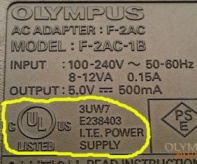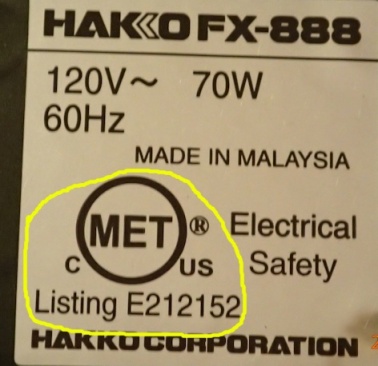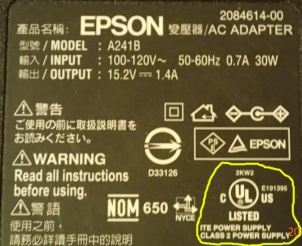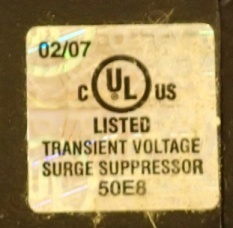Archive for December 2013
“Approved by a certification agency…” a question of safety
Our electrical system in Canada is highly regulated. From the rates that may be charged, the routes that power lines may take, right down to the $4 charger you plug into the wall there is a web of legislation, regulation and code that controls all aspects of electricity. This is a good thing, as one of the principle goals of that framework is to protect those who use electricity. Specifically for consumers, there is an absolute requirement to have electrical devices approved by a certification agency before they can be sold.
This is enacted on a province-by-province basis. There are minor variations, but the entire framework rests on the back of the Canadian Electrical Code (CEC). That code is published by the Canadian Standards Association (CSA) every four or so years, and is adopted on a provincial basis. Once adopted, the CEC becomes like a regulation in terms of standing…the adoption brings the independent standard into the framework of laws.
In Alberta, the Safety Codes Act sets out the authority to make this happen. Notes bringing the Alberta-specific application into being are published by the Department of Municipal Affairs. For the approval process, this is what is set out:
Rule 2-024 of the Canadian Electrical Code (CEC) requires that electrical equipment be approved. The CEC defines “approved” in Section 0.
In Alberta, section 2 of the Electrical Code Regulation prescribes the conditions for the use of equipment related to electrical systems and applies these requirements to the term “approved” as referenced in the Code. Section 2 of the Electrical Code Regulation reads as follows:
2(1) If a code, standard or body of rules declared in force under the Act with respect to electrical systems requires approved equipment, that equipment must meet the requirements of this section.
(2) No person shall manufacture, install, sell or offer for sale any equipment related to electrical systems for use in Alberta unless the equipment has been
(a) certified by a certification body in accordance with the certification body’s terms of accreditation with Standards Council of Canada, or
(b) inspected by a inspection body in accordance with the inspection body’s terms of accreditation with Standards Council of Canada
(3) Subsection (2) does not apply to electrical equipment of an electric distribution system or transmission lines as defined in the Hydro and Electric Energy Act.
The regulation defines “certification body” and “inspection body” as follows:
“certification body” means an organization accredited by the Standards Council of Canada as a certification body.
“inspection body” means an organization accredited by the Standards Council of Canada as an inspection body.
Products certified by an accredited certification body are approved; also, products deemed acceptable by an inspection body through a field evaluation process are also approved.
Now, this is all much hand waving that leads to the question – what’s the point?
First point – notice that it is against the law to sell un-certified electrical equipment in Canada (I bolded the definitive words above). That shop that has brought in an Asia electrical product to sell cheaply, if that item is not approved, is committing an unlawful act. There is also the possibility of civil liability – if you’re selling unapproved electrical devices, and someone is killed or injured as a result, or a building burns down, you can be sure the people that broke the law will be involved in the lawsuit.
In my hobby-job as a forensic engineer, I come across lots of different types of electrical equipment in all areas of use: industrial, commercial and residential. One of the trends I have noticed over the past decade is a literal explosion in the amount of un-approved electrical gear coming up for sale.
This started with the higher-end electrical components such as industrial circuit-breakers, which are being counterfeit overseas and distributed into the North American market place. The high cost of these items make them attractive items to fake. The problem – none of the fake breakers have been through a test process, so there is no guarantee that they will function when required. If you’re talking about a 1,200 amp 3-phase breaker in a large industrial complex, and it doesn’t remove the electrical source when a fault happens, you’re talking about a really, really bad day.
Now, I see all sorts of consumer electronics that are not certified. There have been a number of stories circulating about people electrocuted by unlicensed, un-certified iPhone chargers. This is a huge problem overseas, and we are starting to see hints of it here. A report from the UK documents literally tens of thousands of these chargers that are being sold in discount bins.
From the consumer’s point of view, you can understand the attraction. Do you buy the name-brand Apple charger for $25, or get the much cheaper one you found at an online site? We live in an era when there is not a huge amount of understanding of the technical complexity of electronic devices, so if it looks ok, and seems to work, why not accept the $5 version?
I recently completed a fire investigation where a number of electrical components being used were not approved for use in Canada. These had been purchased through an Alberta hobby store for use by a technically-specialized group of hobbyists. The lack of approval had nothing to do with the fire…but one of the things I discovered was that a power supply (a high-current power supply) in a metal case did not have the case properly bonded to the grounding wire – a requirement of code in Canada basically forever. This is a major safety issue – the case ground on a metal-cased device is intended to prevent electrocution if a live wire happens to touch the case, followed by a person touching the case. The un-grounded case was also the mounting heat-sink for the power transistors (which I suspect is the reason it was left un-grounded).
Here is a recent, local example of unapproved equipment being sold in a local store. This is obviously not only a European issue any longer. This is now one of my first steps when I’m investigating – to determine if the involved components were approved electrical devices.
This really came home for me when I bought a hot-air rework station from a BC supplier. The price was really amazing, considering most of these stations start around $700…and I should have known that a price that’s too good to be true, probably is.

When I set it up, my first look was to confirm there was a certification mark on the case…
…which there was not. Much like what I saw in that fire investigation, the unit was marked with the CE symbol (a European marking, probably forged) that has no standing in Canada. Even in Europe this is only a self-declared status, unlike the Canadian requirement which is for testing by an accredited testing agency to prove safety and compliance.
The rule in such dealings is really caveat emptor (buyer beware), and I make it a point to check for the certification symbols on anything I buy. There are some things that don’t need those marks (a low-voltage device like a scanner may not have a mark, but the power adapter must). Even the presence of a symbol can’t be a perfect sign, as the counterfeiters are now including phony approval symbols…but it’s the best we can do. If you purchase through a known supply chain (an established store or web store) this helps, but even places like Amazon and Canadian Tire are not immune.
I’ll end this post with some examples of what approved device labels look like. One other clue is the completeness of the label. The rules require electrical devices also be marked with manufacturer’s name, the supply voltage and any caution statements. Most approved items sold in Canada will have an extensive label (and no spelling mistakes, another sign of possible counterfeit items).
These two are adaptors, one for a camera, one for a scanner. I’ve circled the certification marks in yellow – in both of these the certifying agency is Underwriters Laboratories (UL) and the subscript ‘C’ and ‘US’ mean the certification is valid in both Canada and the United States.

Note in both cases the presence of an ‘E’ number (E238403), which is the certification number – with this you can go to the UL website and look up the specific standard that was used to certify the device, and to confirm it is the correct manufacturer. Note also each label has a ton of information about who made it, the input and output power and what type of device (ITE Power Supply).

This next one is a Samsung harddrive from a different investigation. The certification mark in this case is the reversed RU (standing for Meanwell, a Chinese company. Note the ‘C’, ‘US’ and the ‘E’ number.
This label shows a number of European certifications (none of which have standing in Canada): the CE mark, which is self-declared unlike the Canadian remarks that require a device be proven safe by an independent test agency. Just under the right side of my yellow paint you can see a German mark ‘TUV’.
This last pair are my Hakko solder station and a surge-suppressed power bar. The Hakko station has a manufacturer’s mark ‘MET’ with the ‘C’ and ‘US’ marks, along with an ‘E’ number. The power bar tag is a holographic tag (one of the steps taken to make counterfeiting more difficult) – there is a large listing of technical information marked just adjacent to the tag.mpany), again with the ‘US’ and ‘C’ marks. Individual test labs can use their own logo, as long as it is approved and registered.

Last word – the place you have to be most cautious is in purchasing the lower-cost consumer items like power adapters or Christmas lights. Make sure when you buy such things that they have a visible certification mark, like shown above. There’s a larger listing of marks here. While I’ve focused on electrical items in this post, there are similar requirements for certification for gas appliances such as furnaces or stoves.
Particularly check when buying things like power bars and extension cords. In these cases you really do get what you pay for. If the dollar store has a big bin of power bars on sale so cheap you can’t believe it…look for that certification mark. If you can’t find it, move on and pay a few dollars more.
Here’s a quick summary of some of the marks in use in Canada (note the use of the subscript ‘C’):
Military Training, long ago and far away
I had recent occasion to be reminded of some fun military training I did between 18 and 19 years of age. I had two separate opportunities to learn helicopter rappelling. It makes my palms wet to think about it now, but at the time it was a great adventure. It was these pictures (from St Jean, PQ) that brought back the memories – although these are Griffin helicopters, and we were using Twin Hueys “back in the day”
I also recall going 4 per side…perhaps reflecting the Huey’s larger overall dimensions (and design intent, as the Griffin is mostly a civil pattern helicopter painted green).
The rappel master would stand in the middle of the helicopter. You started sitting on the edge of the floor with your feet dangling out over the skid and a bag of coiled rope between your legs. Once at altitude (170 feet I think), the master would tell you to dump the rope. Once the ropes were deployed, he would yell ‘get ready’, at which point you climbed out onto the skid and turned around and released enough rope so as to be almost horizontal. He would then point at opposing pairs and shout ‘go!’, and you would kick off from the skid, release your brake hand and slide down to the ground quickly…braking before impact.

On my third go of the second time I did this, the UTPM on the skid next to me lost his footing and fell sideways into me, knocking me off the skid. I was hanging upside down from the rope, with one leg along the skid and the other in space. The UT started to rappel, but his rope was trapping my leg against the skid, and I could not move it. I had to wait until he was off the rope to free my leg…so I was the last one down by far. I recall the rappel master leaning out the door and looking down at me while telling the pilots that they had a hung-up jumper.
I wasn’t frightened at that point, more upset at the UT for knocking me off. I had rappelled enough that I knew with my brake on I wasn’t going anywhere…even if they had to land with me hanging from the skid. Fun times.
Grace Hopper’s Birthday
I do appreciate Google’s reminders of important dates, today is Grace Hopper’s birthday (were she still alive).
Reading her history, she was an amazing woman.
My encounter with her came at Royal Roads Military College in 1984 (I was there for a spa weekend), when she came to talk to us about her life in computers. She handed out short segments of wire that she told us was the only way she could conceive of a nanosecond – by the piece or wire equal to the length that an electrical signal would travel in a nanosecond.
It reminded me that science that can’t be practically explained to anyone is weakened – Richard Feynman’s work in physics, but also his stark demonstration of the effects of cold on space shuttle solid rocket booster O-rings.
Happy birthday, Grace.
The Jesus Problem?
(I wrote this several years ago and lost track of it)
A 2008 article published in Maclean’s titled, “The Jesus Problem”, set my fingers itching to pen a response. Life intervened which was good, as it gave me a chance to reflect and changed my initial anger into mournful (and prophetic) reflection.
The article is written with a clear anti-Christian focus. I won’t document this except to point out that the writer is clearly biased against the One Faith once given, and very welcoming of “modern” bible scholarship which, “…sweeps all that away, along with the miraculous elements…”. What remains is Jesus, the ‘nice guy’, who never wanted to be God, never spoke of judgment, but was a good teacher and whose simple message was corrupted after his death by those who wanted to build a church on his legacy.
That ‘nice guy’ Jesus never said, “’Not every one who says to me, Lord, Lord,’ shall enter the kingdom of heaven, but he who does the will of my Father who is in heaven.” Rather, the article is written around the equation that the personal, “Jesus is Lord” equals the impersonal, “love is supreme”. With that, Jesus is pushed aside as a curiosity of history and our own, modern (and without saying, more wise and knowledgeable) understanding of love is substituted.
Now all that remains to guide us is our own itching ears, and a human wisdom that fails to even approximate God’s wisdom.
The author cites Gretta Vosper, a United Church of Canada pastor and author of a book outlining the direction the ‘new’ liberal church must follow (With or Without God). Now that liberalism has gutted God and Jesus of any divinity, it seems, they have found themselves suffering the consequences of their actions. “But the wound on the left [of the church] has gone unnoticed and has hemorrhaged into nothingness as religious quests have become spiritual quests unconnected with church.”
Funny. So the liberal church has spent the past 100 years destroying the faith passed on to them, and now finds all their followers have left to follow private spiritual questions – usually some syncretistic mass of a multitude of religious elements (so we now have ‘christian yoga’; ‘christian buddhists’; ‘christian materialist rationalists’ and so on). Is that not the logical consequence of telling people that God is dead?
The author skirts around that question, because once you gut God of any divinity and reduce Jesus to one of the few lucky great teachers to be remembered by history (who perhaps retired to Scotland to raise a family with Mary Magdalene or John the Baptist, depending on which sexuality you wish to promote), why do you even bother to attempt to hold together a faith community? If the full scope of my spirituality is my own mind, why don’t I just stay home and focus on myself? This is the real gift of modernity, I think, therefore I am, becomes the end all philosophy that defines my being.
The lunacy of that position seems to be lost on Vosper, who wants a church full of people willing to listen to her wisdom…but that embraces a neutered Jesus. “When Gretta Vosper looks at the emerging historical Jesus she sees no rock on which to erect a church. ‘In trying to capture exactly what he said, we have found, quite by accident, that what he said has little power.’” She goes on, “If we say we follow Jesus without clarification, we allow the assumption that we agree with all of his ideas, including the bad ones.”
Wow, it just gets better and better. With the travesty of ‘modern’ biblical scholarship, over the assumption that we are wiser and more knowledgeable than all who have gone before, we remove God from the Bible and leave behind only the sayings which fit with our view of the way things should be. Nothing is left but mammon – the perfect, wise human being. To quote my priest, who often asks rhetorically how well our own wisdom and efforts have been working to bring us salvation, “How’s that working for you so far?”
Well, the way humanity’s wisdom is working so far has brought us more death, destruction, broken families and children, lawful murder, coming lawful euthanasia, Rwanda, Auschwitz and sayings like ‘Arbeit Macht Frei’. If you object – “That’s not me”, I would challenge you to think carefully about your life, to see if your hands are that lily white. My observation (because I know the darkness of my own human self) is that anyone who can claim self-purity has not grown past the point of self-deception. Paul’s comment on, ‘when we say we have no sin…’, doesn’t end up with affirmation of the self, but the affirmation of our ability to lie effectively to ourselves.
Our human history, when God is pushed out of our lives, is one of death and chaos – and there has not been a single historical example to the contrary. Every attempt to make a utopian society has failed, some dramatically. Why? As we know from God’s Word – all attempts made by man to pick ourselves up by our bootstraps is doomed to failure. We cannot redeem ourselves, let alone the rest of the world.
That is, of course, exactly the rock upon which Vosper and the writer of the article place their hope – the altar of human ability.
“[Jesus] taught acquiescence in oppression, ‘a stance not at all helpful in ending slavery, racism, patriarchal hierarchy, and so on.’ ” The Lord’s word on violence is seen by these as not at all helpful at changing the world. Suddenly, taking up arms to fight oppression seems a very ‘christian’ thing to do. Oscar Romero’s insistence that his priests not follow the path of violence, even when that stance led to his murder, now becomes a part of the ‘patriarchal’ failure of Christ. As NT Wright pointed out, liberation theology arises when the church forgets that God’s justice (or righteousness) bears little resemblance to human ideas of justice, or ‘just desserts’.
So we’re justified in taking extreme actions (blowing up pipelines?) to protect the creation, because we have usurped God’s righteousness (justice) with our own end justifies the means philosophy that can justify anything. As long as the goal fits within our wisdom’s assessment of what is needed, why pay any attention to the way of peace proclaimed by Christ?
As much as I hate to offer extended quotations from someone who has little time for God, the error in Vosper’s thought comes through clearly in her summation statements.
“ ‘Jesus’ moral teaching is not outstanding.’ And it’s impossible to craft a moral high ground from his life, works and sayings: ‘His words are dead to many people. The world has changed, The words don’t make sense any more.’ And they aren’t necessary. ‘Why do we need a revolutionary voice from two millennia ago to guide us? We have fabulous ideas of our own, that are constantly weakened by having to tie them back to Jesus and Scripture.”
And so, we cut all ties to the dated and quaint teachings of a no-import carpenter from Galilee, and set forth sailing in a ship powered by sails of our own fabulous making. When the weak and fragile cloth rips, and we are left in irons (with no propulsion), our only conclusion is that we need adopt the next great human thought that comes along.
Those ‘fabulous ideas of our own’ will continue to bring us nothing but death and destruction and chaos and, ultimately, a life without meaning.
A young woman with a family is told she is going to die in mere months because of inoperable cancer – what do those ‘fabulous ideas of our own’ have to offer her? Sorry, they say, better luck next time. That bankrupt faith is what leaves so many in hospital beds complaining, ‘I lived a good life – how come I suffer now?’
No. That woman’s faith in Christ allows her to reply, “Thank God he has trusted me with this.”, for even death is given great meaning in Christ, the one whom even death could not hold.
Those who have come to know God, a deeply intimate and personal relationship that has literally reordered our entire being, know that our ideas only have worth in the context of that relationship. My engineering knowledge and skill exists without purpose, until I turn it and surrender it to the Great Reality, and give all I do to the greater glory of God. My bank account, my investments, my family and most of all myself, exist without meaning, until I give it all to Jesus. Only in the light of Christ do I see myself as God sees me: fearfully and wonderfully made, made to serve and worship God. A relationship that does not bring chaos, or sadness or slavery, but a relationship which brings me the only real freedom that exists in the entirety of creation…freedom in Christ Jesus.






